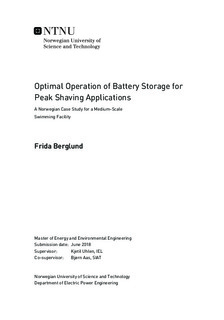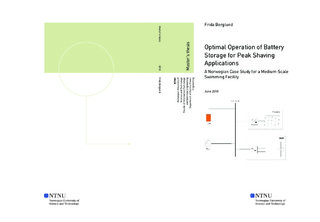| dc.description.abstract | With the vast implementation of power-demanding devices, the grid is facing supply challenges. A promising solution could be to implement a peak demand charge, thus encouraging end users to reduce their power demand. Commercial users are already subject to this demand charge, and are billed for the highest peak power drawn from the grid each month. A special type of customer are sports facilities, as they tend to have high, continuous load demand with extreme peak power periods during busy hours or events. The resulting cost of peak power may be substantial, and contribute to a large share of the total cost of electricity. As such, there is an incentive for the facilities to reduce their power demand. However, doing so in terms of shifting the load to off-peak hours is not always an available option, as the load demand may be highly dependent on external factors. An alternative solution may be to implement battery storage, where energy is bought from the grid during off-peak hours, and discharged to supply the load during on-peak hours. This is called peak shaving, and could both relieve the grid of stress as well as reduce the cost of peak power for the facility.
In this thesis, the economic benefits of implementing battery storage into an existing grid-connected PV system for a medium-scale swimming facility is studied. The objective is to minimize the total cost of electricity, including the cost of energy and peak power demand, while ensuring longevity of the battery. The degradation of the battery is modelled as an operational cost, and is included in the objective function. An optimization model based on multi integer linear programming is built, and simulated using a one year time horizon in GAMS and Matlab. Several studies are carried out using an hourly real-time pricing scheme and data from Holmen swimming facility, however the model can easily be adapted to fit any load and production profile.
The main results reveal that installing a battery storage system is economically attractive today, with a net savings on the total system cost of 0.64% yearly. The cost of peak power is reduced by 13.9%, and the savings from peak shaving operation alone is enough to compensate for the yearly cost of the battery. Moreover, the battery ensures additional revenue by performing price arbitrage operations. The yearly degradation of the battery is found to be 7.15\%, and the optimal battery size is 150 kWh. When simulating the system for an assumed 2030 scenario, the battery is found to be even more profitable with a yearly net savings of 4.15%. | |

